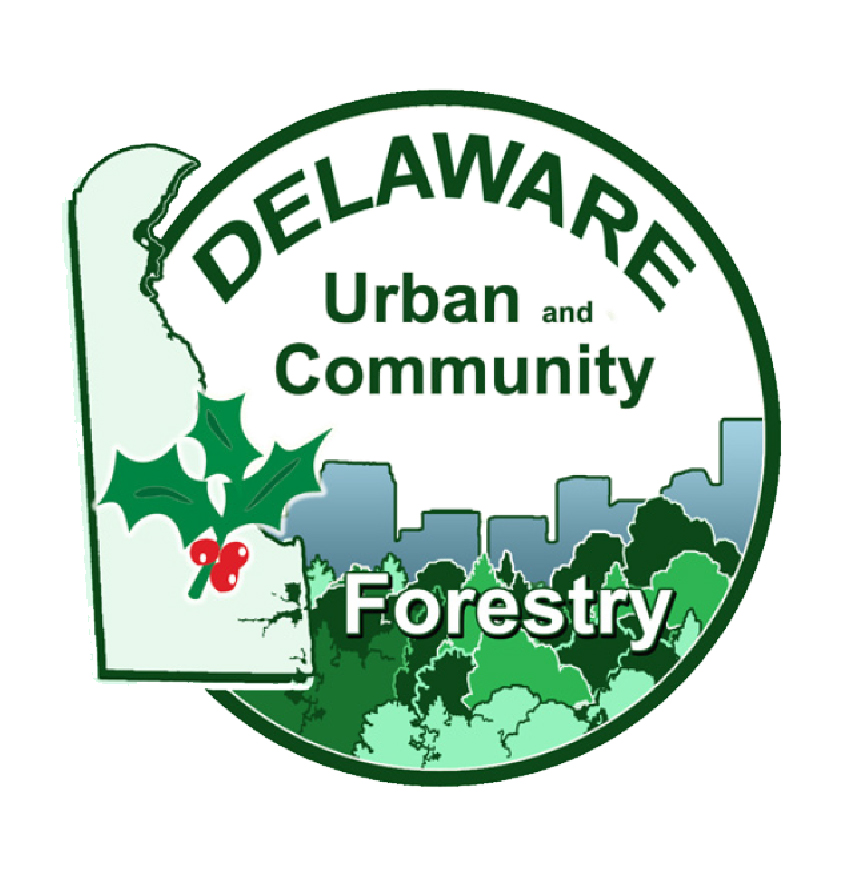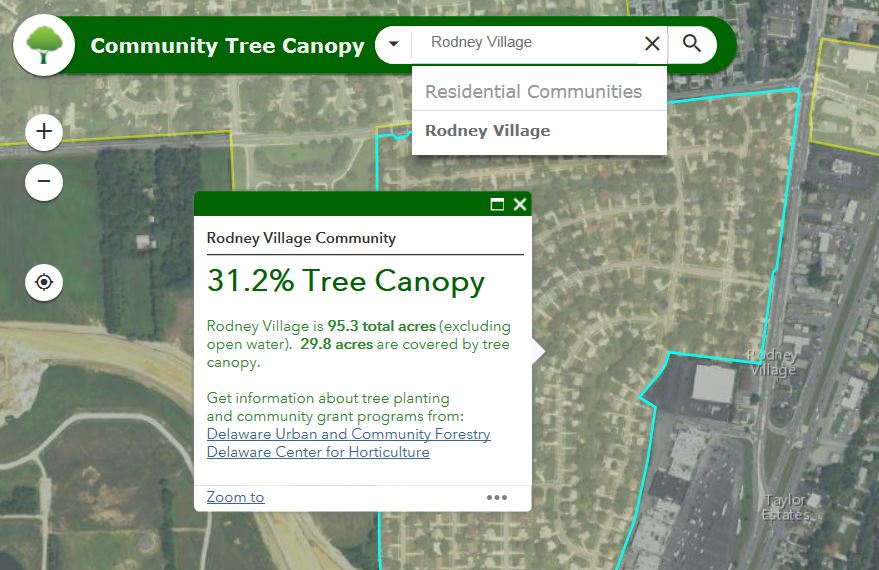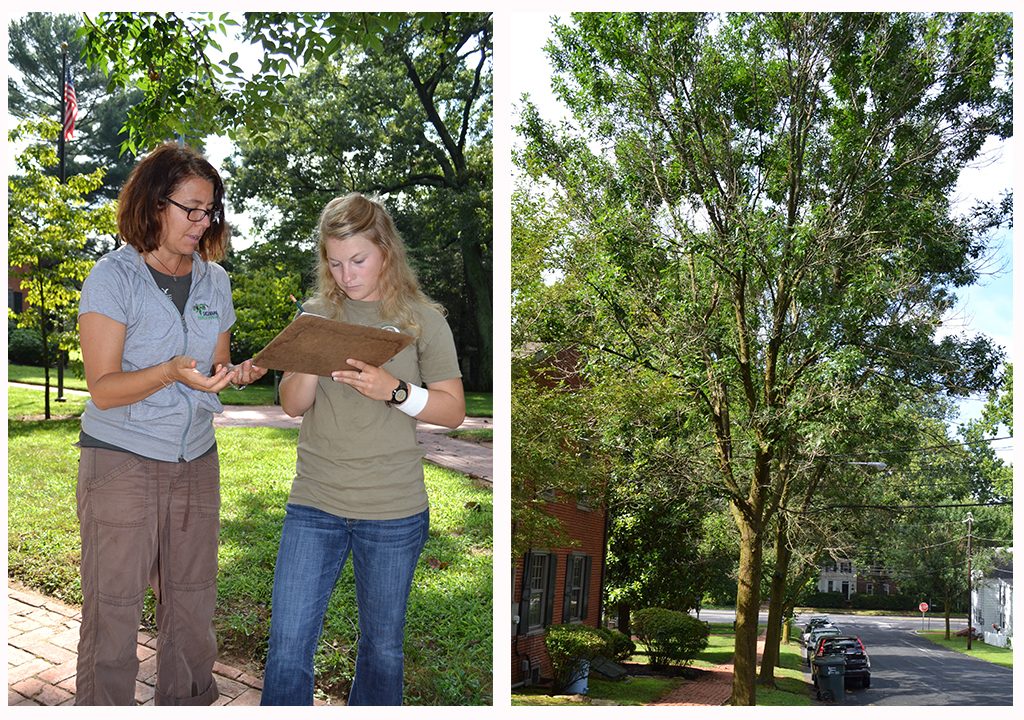New online tool to assess community tree canopy in Delaware
Department of Agriculture | Forest Service | Kent County | New Castle County | Sussex County | Date Posted: Wednesday, March 29, 2017
Department of Agriculture | Forest Service | Kent County | New Castle County | Sussex County | Date Posted: Wednesday, March 29, 2017

DOVER, Del. – The Delaware Forest Service (DFS) has unveiled a new online tool that uses geographic information systems (GIS) software to help cities, towns, and neighborhoods to measure and increase their community tree canopy percentage. The link is: de.gov/treecanopy
Developed by the Delaware Department of Agriculture’s GIS specialist Jimmy Kroon, the tool covers the entire First State: municipalities, homeowner associations, and neighborhoods can assess their current level of tree cover as a starting point to explore opportunities to plant new trees or maintain their existing ones.

Tree canopy is important because trees provide numerous natural benefits for air and water quality, lower heating and cooling costs, a reduction in harmful UV radiation, as well as other environmental and social benefits. In particular, trees mitigate the soil erosion and stream pollution caused by impervious surfaces and storm water run-off in urban areas. Studies show that trees can improve property values and provide scenic beauty, reduce summer peak temperatures, and even improve social ties among neighbors, factors that can help a community attract businesses and residents. One study found a 10% increase in tree cover was linked to a 12% decrease in crime .

Urban tree canopy (UTC) assessment is used to help decision-makers understand their urban forest resources, particularly how much tree canopy currently exists and the amount that could exist. This enables citizens and public officials to identify “plantable space” to locate trees. The UTC assessment protocols have been applied to dozens of counties, cities, and towns in the United States and Canada. The assessments help inform UTC goals, prioritize tree planting locations, establish urban forestry master plans, and justify spending and potential return on investment (ROI) for urban forestry programs.

In Delaware, state forestry staff work with cities, towns, and communities to increase tree canopy through urban grants and technical assistance. Once the baseline of tree canopy has been established, urban foresters can help communities set goals to increase their percentage. According to Kesha Braunskill, Delaware Forest Service’s urban and community forestry program director, the following municipalities have adopted formal resolutions to increase and/or maintain their tree canopy:
“We hope this new online tool will help people focus on the many benefits of trees as well as the need to increase tree canopy statewide,” said Braunskill. “We can magnify the numerous benefits of our urban forests by simply planting more trees in our communities and developments.”
The Delaware Forest Service’s goal to keep and increase existing canopy is balanced against a concern that some people are taking out trees unnecessarily. In general, tree removals should be considered when the tree poses a hazard or a risk assessment shows a “safety” or “tree health” issue. In addition to asking the Delaware Forest Service for help, those with concerns are also advised to only consult companies with arborists certified by the International Society for Arboriculture (ISA). Because trees are so beneficial, the advice is generally if you “remove a tree” then “replace a tree.”
As part of the Delaware Forest Service’s annual tree grant process, applicants who seek funding for tree removals must provide for the tree’s replacement, a requirement also adopted by ordinances in Rehoboth, Lewes, and Wilmington. Similarly, every municipality that applies for an urban and community grant must also have a tree canopy goal.
There are currently tree canopy maps in PDF form for all 57 incorporated municipalities, but the new GIS tool allows those outside municipal boundaries to also be aware of the benefits of keeping and increasing their tree cover. Even homeowner associations can set goals: Tavistock in New Castle County, for example, has adopted a tree canopy resolution. The Delaware Forest Service offers technical assistance on tree planting, lists of recommended trees, site evaluation, tree ordinance, and setting tree canopy goals. The agency also sponsors a website, delawaretrees.com, where residents can learn about the work of the urban and community forestry program and even read a “Tree Owner’s Manual” to learn about how to select, plant, and care for a new tree.
For more information, contact Kesha Braunskill at kesha.braunskill@delaware.gov
Keep up to date by receiving a daily digest email, around noon, of current news release posts from state agencies on news.delaware.gov.
Here you can subscribe to future news updates.
Department of Agriculture | Forest Service | Kent County | New Castle County | Sussex County | Date Posted: Wednesday, March 29, 2017

DOVER, Del. – The Delaware Forest Service (DFS) has unveiled a new online tool that uses geographic information systems (GIS) software to help cities, towns, and neighborhoods to measure and increase their community tree canopy percentage. The link is: de.gov/treecanopy
Developed by the Delaware Department of Agriculture’s GIS specialist Jimmy Kroon, the tool covers the entire First State: municipalities, homeowner associations, and neighborhoods can assess their current level of tree cover as a starting point to explore opportunities to plant new trees or maintain their existing ones.

Tree canopy is important because trees provide numerous natural benefits for air and water quality, lower heating and cooling costs, a reduction in harmful UV radiation, as well as other environmental and social benefits. In particular, trees mitigate the soil erosion and stream pollution caused by impervious surfaces and storm water run-off in urban areas. Studies show that trees can improve property values and provide scenic beauty, reduce summer peak temperatures, and even improve social ties among neighbors, factors that can help a community attract businesses and residents. One study found a 10% increase in tree cover was linked to a 12% decrease in crime .

Urban tree canopy (UTC) assessment is used to help decision-makers understand their urban forest resources, particularly how much tree canopy currently exists and the amount that could exist. This enables citizens and public officials to identify “plantable space” to locate trees. The UTC assessment protocols have been applied to dozens of counties, cities, and towns in the United States and Canada. The assessments help inform UTC goals, prioritize tree planting locations, establish urban forestry master plans, and justify spending and potential return on investment (ROI) for urban forestry programs.

In Delaware, state forestry staff work with cities, towns, and communities to increase tree canopy through urban grants and technical assistance. Once the baseline of tree canopy has been established, urban foresters can help communities set goals to increase their percentage. According to Kesha Braunskill, Delaware Forest Service’s urban and community forestry program director, the following municipalities have adopted formal resolutions to increase and/or maintain their tree canopy:
“We hope this new online tool will help people focus on the many benefits of trees as well as the need to increase tree canopy statewide,” said Braunskill. “We can magnify the numerous benefits of our urban forests by simply planting more trees in our communities and developments.”
The Delaware Forest Service’s goal to keep and increase existing canopy is balanced against a concern that some people are taking out trees unnecessarily. In general, tree removals should be considered when the tree poses a hazard or a risk assessment shows a “safety” or “tree health” issue. In addition to asking the Delaware Forest Service for help, those with concerns are also advised to only consult companies with arborists certified by the International Society for Arboriculture (ISA). Because trees are so beneficial, the advice is generally if you “remove a tree” then “replace a tree.”
As part of the Delaware Forest Service’s annual tree grant process, applicants who seek funding for tree removals must provide for the tree’s replacement, a requirement also adopted by ordinances in Rehoboth, Lewes, and Wilmington. Similarly, every municipality that applies for an urban and community grant must also have a tree canopy goal.
There are currently tree canopy maps in PDF form for all 57 incorporated municipalities, but the new GIS tool allows those outside municipal boundaries to also be aware of the benefits of keeping and increasing their tree cover. Even homeowner associations can set goals: Tavistock in New Castle County, for example, has adopted a tree canopy resolution. The Delaware Forest Service offers technical assistance on tree planting, lists of recommended trees, site evaluation, tree ordinance, and setting tree canopy goals. The agency also sponsors a website, delawaretrees.com, where residents can learn about the work of the urban and community forestry program and even read a “Tree Owner’s Manual” to learn about how to select, plant, and care for a new tree.
For more information, contact Kesha Braunskill at kesha.braunskill@delaware.gov
Keep up to date by receiving a daily digest email, around noon, of current news release posts from state agencies on news.delaware.gov.
Here you can subscribe to future news updates.